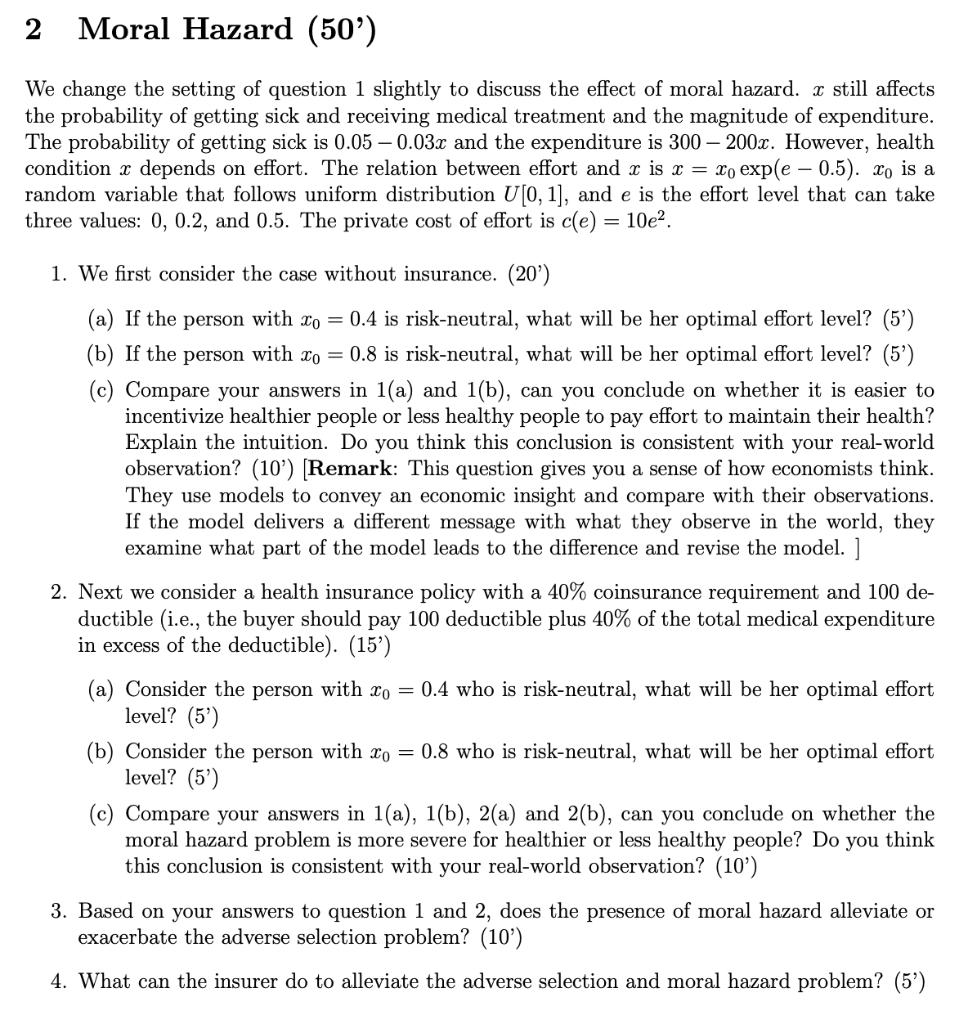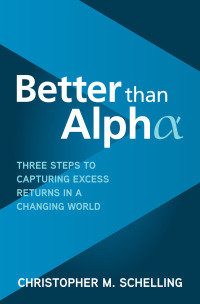
2 Moral Hazard (50) We change the setting of question 1 slightly to discuss the effect of moral hazard. x still affects the probability of getting sick and receiving medical treatment and the magnitude of expenditure. The probability of getting sick is 0.05 0.03x and the expenditure is 300 200x. However, health condition x depends on effort. The relation between effort and x is x = xo exp(e 0.5). xo is a random variable that follows uniform distribution U[0, 1], and e is the effort level that can take three values: 0, 0.2, and 0.5. The private cost of effort is cle) = 10e2 1. We first consider the case without insurance. (20') (a) If the person with co = 0.4 is risk-neutral, what will be her optimal effort level? (5') (b) If the person with zo = 0.8 is risk-neutral, what will be her optimal effort level? (5') (c) Compare your answers in 1(a) and 1(b), can you conclude on whether it is easier to incentivize healthier people or less healthy people to pay effort to maintain their health? Explain the intuition. Do you think this conclusion is consistent with your real-world observation? (10') [Remark: This question gives you a sense of how economists think. They use models to convey an economic insight and compare with their observations. If the model delivers a different message with what they observe in the world, they examine what part of the model leads to the difference and revise the model. ] 2. Next we consider a health insurance policy with a 40% coinsurance requirement and 100 de- ductible (i.e., the buyer should pay 100 deductible plus 40% of the total medical expenditure in excess of the deductible). (15') (a) Consider the person with 20 = 0.4 who is risk-neutral, what will be her optimal effort level? (5) (b) Consider the person with Xo = 0.8 who is risk-neutral, what will be her optimal effort level? (5') (c) Compare your answers in 1(a), 1(b), 2(a) and 2(b), can you conclude on whether the moral hazard problem is more severe for healthier or less healthy people? Do you think this conclusion is consistent with your real-world observation? (10') 3. Based on your answers to question 1 and 2, does the presence of moral hazard alleviate or exacerbate the adverse selection problem? (10') 4. What can the insurer do to alleviate the adverse selection and moral hazard problem? (5') 2 Moral Hazard (50) We change the setting of question 1 slightly to discuss the effect of moral hazard. x still affects the probability of getting sick and receiving medical treatment and the magnitude of expenditure. The probability of getting sick is 0.05 0.03x and the expenditure is 300 200x. However, health condition x depends on effort. The relation between effort and x is x = xo exp(e 0.5). xo is a random variable that follows uniform distribution U[0, 1], and e is the effort level that can take three values: 0, 0.2, and 0.5. The private cost of effort is cle) = 10e2 1. We first consider the case without insurance. (20') (a) If the person with co = 0.4 is risk-neutral, what will be her optimal effort level? (5') (b) If the person with zo = 0.8 is risk-neutral, what will be her optimal effort level? (5') (c) Compare your answers in 1(a) and 1(b), can you conclude on whether it is easier to incentivize healthier people or less healthy people to pay effort to maintain their health? Explain the intuition. Do you think this conclusion is consistent with your real-world observation? (10') [Remark: This question gives you a sense of how economists think. They use models to convey an economic insight and compare with their observations. If the model delivers a different message with what they observe in the world, they examine what part of the model leads to the difference and revise the model. ] 2. Next we consider a health insurance policy with a 40% coinsurance requirement and 100 de- ductible (i.e., the buyer should pay 100 deductible plus 40% of the total medical expenditure in excess of the deductible). (15') (a) Consider the person with 20 = 0.4 who is risk-neutral, what will be her optimal effort level? (5) (b) Consider the person with Xo = 0.8 who is risk-neutral, what will be her optimal effort level? (5') (c) Compare your answers in 1(a), 1(b), 2(a) and 2(b), can you conclude on whether the moral hazard problem is more severe for healthier or less healthy people? Do you think this conclusion is consistent with your real-world observation? (10') 3. Based on your answers to question 1 and 2, does the presence of moral hazard alleviate or exacerbate the adverse selection problem? (10') 4. What can the insurer do to alleviate the adverse selection and moral hazard problem? (5')







